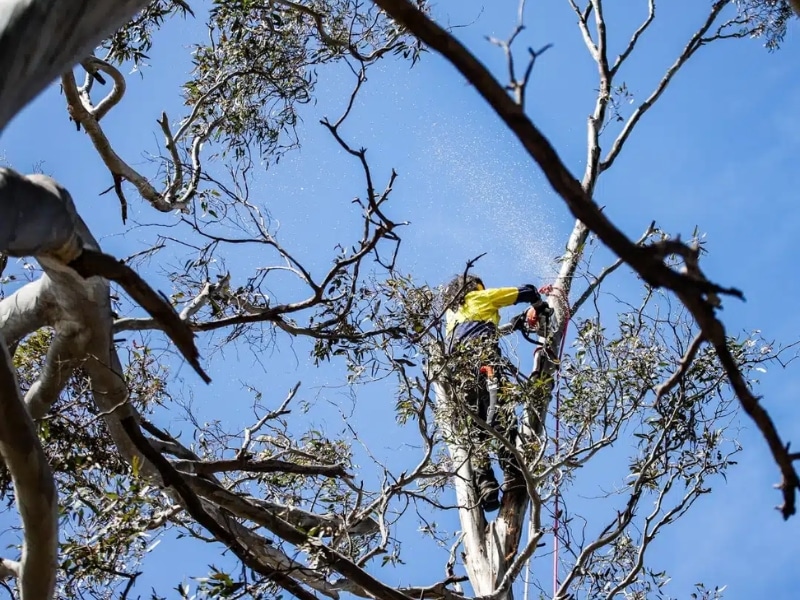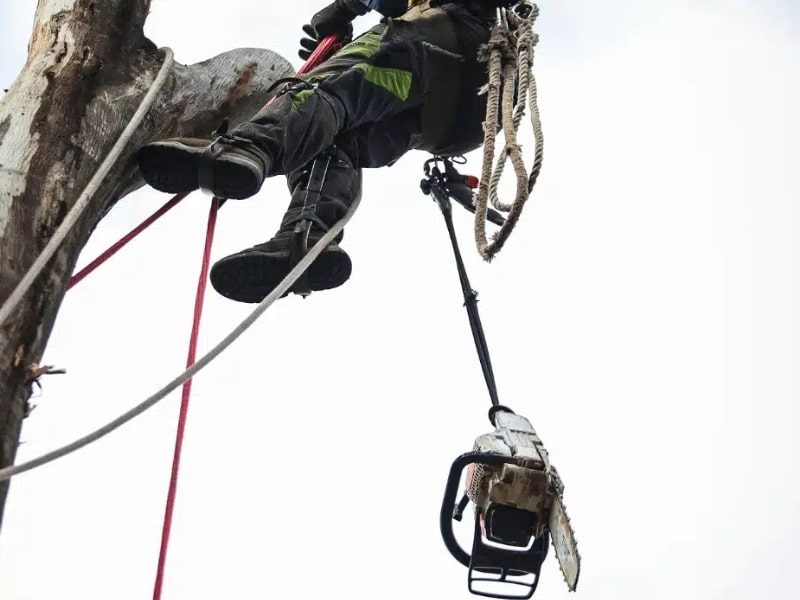Melbourne’s chill might keep many inside, but it also sets the stage for strategic tree maintenance. When it comes to pruning tall trees, colder months offer a unique chance to enhance long-term health and structure. The dormant season reduces sap flow, insect activity, and the risk of infection, allowing trees time to heal from clean cuts. With fewer leaves, limbs are more visible, and the tree’s framework becomes easier to shape. This article explores when and why winter is the right time to prune, what tools and risks to consider, and how to know when to call an expert.
What are the risks of pruning tall trees during Melbourne’s winter?
Even though trees are less active, pruning during winter isn’t without its challenges. You’ll need to think through safety, tree response, and how cold weather can complicate each step.
- Wet bark increases slip risk: Melbourne’s wet winters make branches, ladders, and work boots slippery — a serious hazard when pruning tall trees. Use non-slip boots, harnesses, and stable platforms to reduce accidents.
- Brittle limbs snap unpredictably: Cold makes wood less flexible, raising the chance of splitting or cracking even healthy limbs. Pruning without understanding tension points can make things worse.
- Reduced healing time: While dormancy limits sap loss, frost exposure after cuts can slow healing and allow fungal spores to settle. Pruning cuts must be clean and made at the right angles.
- Equipment failure from low temps: Petrol and battery-powered gear often needs winterisation to avoid stalling or jamming mid-cut. Regular maintenance and warm storage extend reliability.
With these challenges in mind, using safe and reliable options for pruning tall trees is often the smarter and safer choice.
What signs indicate it’s time to schedule tree maintenance?
Winter is often when tree stress reveals itself. Some signs are subtle — others demand urgent action.
- Bark is cracking or shedding: This may indicate disease or internal decay. Look for discoloured sap, fungal growth, or a spongy texture.
- Branches are crossing or rubbing: These points often weaken, causing later splits or falls. Early pruning avoids permanent structural problems.
- The canopy is uneven or sparse: This indicates poor nutrient flow or structural imbalance. You may also notice slow budding or colour changes in nearby foliage.
- The tree is leaning further: Even small shifts can signal root damage or soil instability. Check the base of the tree for lifted soil or exposed roots.
If a tree shows any of these, it’s worth asking whether signs that indicate a tree may be hazardous are present, and if it’s time to consult a qualified arborist.
Why is winter the ideal time for pruning tall trees?
Trees drop their leaves in winter, and that makes spotting structural issues much easier. For those tackling large trees, this is a key seasonal advantage.
- The canopy is easier to see through: Without dense foliage, you can view the tree’s branching structure and identify imbalances. Structural defects, such as co-dominant stems and stress fractures, become visible.
- Hidden hazards are exposed: Cracks, pest nests, and deadwood become easier to spot and address directly. This is especially useful for trees growing close to homes or public paths.
- Access to limbs improves: With less brush in the way, arborists can position gear or ladders more precisely and move faster. It’s also easier to set ropes safely and reduce limb drop risk.
- Better visual line clearance in winter: Without foliage, it’s easier to identify and trim back branches that obstruct power lines, signage, or building exteriors — preventing future safety or compliance issues.
These advantages create optimal conditions; additionally, applying proper pruning techniques can maintain fruit production while ensuring the structural integrity of tall trees
Which tools are essential for cold-season arborist work?
A standard tool belt may not be sufficient when temperatures drop. Cold-season pruning requires insulated gear and reliable tools: Low temperatures impact both safety and performance. Arborists need insulated PPE, anti-slip equipment, and tools rated for winter conditions to ensure safety and effectiveness.
| Tool | Use | Cold-Weather Need |
| Pole saws | Reaches high limbs from the ground | Needs anti-slip handles and winter-safe lube |
| Chainsaws | Cuts through large branches | Should support cold starts and warm-up use |
| Rope & pulley kits | Support climbing and limb lowering | Require anti-ice treatment and high durability |
| Safety glasses | Protect your eyes from debris | Must remain fog-free in low temps |
| Climbing harness | Secures the body during elevated work | Should include extra padding and heat lining |
- Insulated gloves: Essential for grip and control, especially when holding vibrating tools. Look for water-resistant outer layers and snug-fitting inner linings.
- Portable lighting: Shorter days mean less working daylight — reliable lights help avoid poor cuts. Headlamps with wide beams keep both hands free.
- First-aid kits with thermal gear: Essential for treating cold-related injuries, such as frostbite or hypothermia. Include heat packs, foil blankets, and waterproof bandages.
- Protective clothing: Layered PPE reduces fatigue and keeps you alert longer. Breathable but wind-resistant fabrics work best when paired with bright outer layers for visibility.
Using the right gear can mean the difference between efficient winter work and injuries that delay your entire season.
Why does pruning tall trees in winter help reduce falling limb hazards?
Winter winds and saturated soil increase the odds of branch failure. Timely pruning helps reduce weight, balance the crown, and remove hazards before they become a problem.
- Deadwood removal reduces risk: Pruning out dry or infected limbs limits how much comes down during storms. These branches often fall without warning, posing serious safety threats.
- Limb weight is redistributed: Thinning heavy limbs prevents tipping or limb tear-outs. It also decreases strain at key joints, supporting long-term growth patterns.
- Improved light flow benefits undergrowth: Clearing the canopy can promote the health of lawns and shrubs. Less shade means stronger turf and fewer fungus-prone damp areas.
- Tree structure is strengthened: Targeted cuts guide future growth and make the tree less likely to drop limbs. This makes the tree more resistant to wind damage.
When structural issues are too advanced, pruning may not be enough; tree removal solutions in Fairfield and other nearby areas may be necessary, especially when you are residing at Fairfield properties where space, safety, and compliance require decisive action.
Is it necessary to obtain permits for tree pruning in Melbourne?
Failing to check regulations can result in costly penalties. Melbourne councils enforce strict rules to protect native vegetation and community tree cover.
- Tree Protection Zones (TPZs) apply: Many councils define TPZs that restrict activity within a tree’s root and canopy space. Ignoring TPZ guidelines can halt a project entirely.
- Permit thresholds vary: Trunk diameter, species type, and location often determine if a permit is required. This includes trees on both private and public land.
- Pruning deadwood isn’t always exempt: Some trees, even dead ones, are protected for ecological reasons. Always confirm permit requirements with your local council before proceeding.
- Fines for illegal work are steep: Penalties may include repair orders, replacement costs, or prosecution. These consequences apply to both homeowners and hired contractors.
Before lifting a blade, always follow the guidelines for professional arborist practices in Victoria to ensure your work stays above board.
Final thoughts
Colder weather might not seem like the ideal time for outdoor work, but it’s often the smartest season to focus on tree care. Pruning tall trees in winter enhances visibility, improves access, and reduces seasonal hazards before they become costly problems. It also supports stronger regrowth by giving trees time to heal before spring. Whether you’re managing safety concerns, reshaping overgrown canopies, or planning for long-term growth, winter provides a critical opportunity. If you’re unsure where to begin or what your trees need, find out how The Yard can support your pruning goals with expert advice tailored to your landscape.



